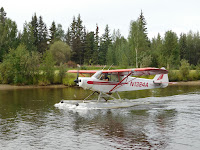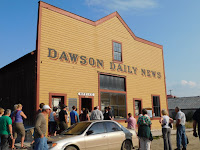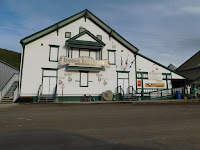The Denali
National Park and Preserve represent the unique flavor of Alaska. From a low spot within the park of 200 feet,
the mountain rises to 20,320 feet in one grand vertical sweep. Not only is it the highest mountain in North
America, Mount McKinley is considered to be the most spectacular rise of any
single mountain on earth.
The mountain
was first called Denali, the “High One,” by the Indian Nation many years
ago. In 1897 the mountain was named
Mount McKinley for President William McKinley.
The park was called McKinley
National Park until 1980 when the name was changed to Denali National
Park. At that time, the park was tripled
in size to six million acres.
Denali
National Park is accessible by the Parks Highway or the Alaska Railroad from
either Anchorage or Fairbanks. In summer
a number of private bus and van services operate daily from these cities. We took a shuttle bus tour of the park. One could get off or on a shuttle as desired. People would get off to hike up a trail and
then take the next shuttle.
Don’t be
fooled by the word “Highway.” Sure, it
was a paved road for maybe ½ mile. Then
the road changed to dirt, and then the road narrowed to about 1½ lanes and it was two-way traffic. Buck and my seat was right behind the driver. The picture on the left shows the section of the road (small horizontal line in the middle of the picture) that we would be driving on in the next picture.
While it was
a warm day for our visit to the park, Denali’s weather changes without
waning. The annual range of temperatures
is extreme, from -54 degrees F to +91 degrees F. Average high for July is 66 degrees.
Snowfalls are not unusual in any month.
In the land of the midnight sun, on June 21 there are 20 hours and 49
minutes of daylight. But on December 21,
there are only 6 hours and 4 minutes of daylight. Check out the beauty of the day in the picture below.
Vegetation
in the park is determined by the strength of the forces of cold air, permafrost,
brief summers, and mountainous topography. At lower elevations, evergreens are
plentiful and the ground is covered with small shrubs.
As we climbed in
elevation on our journey, we noticed that fewer evergreens were present, and
eventually near the top, no trees were present at all. Just the tundra – small hedges, shrubs, bushes,
and mosses.
The animal pictures you saw on Part 1 of the Denali blog were taken at various elevations. The elevation determines the vegetation and the vegetation determines where certain animals will live in the park.
Four visitor
centers serve Denali National Park. The
center most far from the entrance is the Eielson Visitor Center. This is where Buck and I are posing in the
picture below.























































